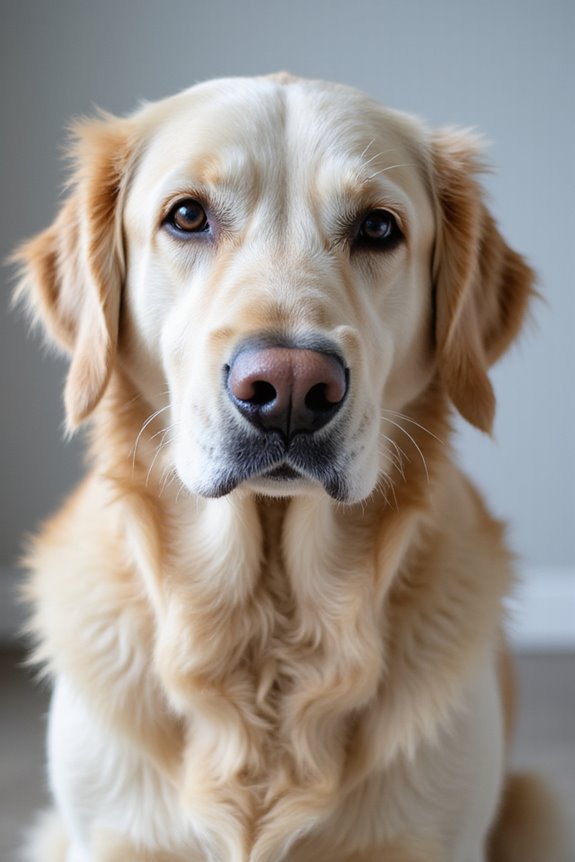To care for a senior dog at home, I recommend prioritizing regular veterinary check-ups every six months to catch health issues early. Guarantee a balanced diet containing high-quality protein and omega fatty acids to support their joints and overall health. Incorporate gentle exercises like short walks to maintain mobility. Creating a safe living environment with non-slip surfaces is vital for their safety. Additionally, providing mental stimulation through interactive toys can enhance their quality of life. More detailed strategies can further enhance their care.
Key Takeaways
- Schedule regular veterinary check-ups to detect health issues early and maintain optimal wellness for your senior dog.
- Provide a balanced diet with high-quality protein and supplements to support joint health and prevent obesity.
- Ensure mobility and safety by using ramps, non-slip rugs, and offering regular low-impact exercises like short walks.
- Engage your dog’s mental and emotional wellbeing with interactive toys, consistent routines, and gentle affection to foster a sense of security.
- Monitor your dog’s health by tracking weight, behavior changes, and medications to share with your veterinarian for effective management.
Importance of Regular Veterinary Check-ups
When it comes to caring for a senior dog, the significance of regular veterinary check-ups cannot be overstated. These biannual visits are essential for early detection of potential health issues, which often develop silently. During these check-ups, preventative screenings allow veterinarians to catch chronic diseases, such as kidney or heart disease, long before symptoms appear.
Additionally, establishing health baselines during these visits helps track changes over time. Regular examinations not only promote longer lifespans but also improve our dogs’ quality of life through proactive care. By monitoring critical signs and behavior, vets can tailor treatments effectively. Staying consistent with these appointments not only provides peace of mind but guarantees we’re doing everything possible to safeguard our beloved senior companions.
Appropriate Diet and Nutrition for Senior Dogs
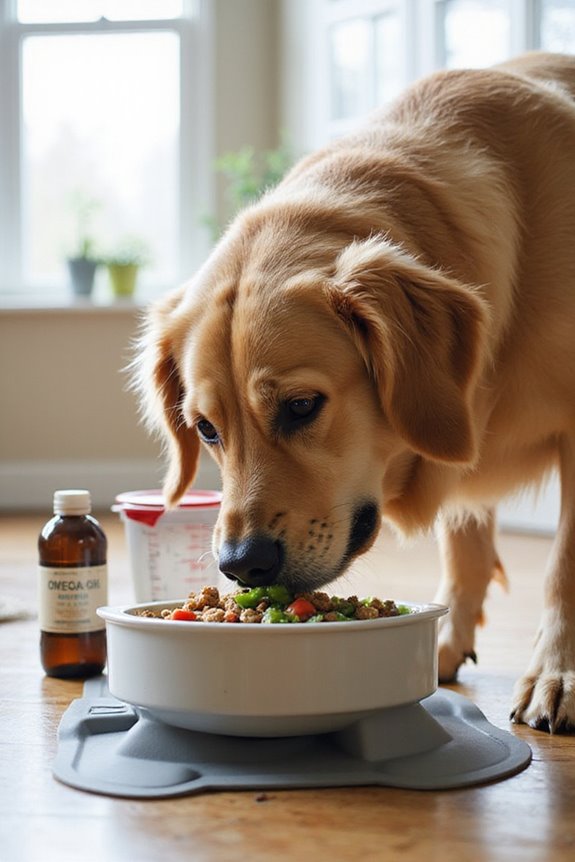
As senior dogs age, their nutritional needs evolve considerably, making it essential to adjust their diet accordingly. Here’s how I approach this important aspect of their care:
- Protein Sources: High-quality protein, around 28-32% on a dry-matter basis, is fundamental for maintaining muscle mass without straining kidneys.
- Fatty Acids: Incorporate omega-3 and omega-6 fatty acids from sources like fish oil; they promote joint health and cognitive function.
- Caloric Adjustments: Adjust calorie intake to avoid obesity; senior dogs require fewer calories due to reduced activity.
- Fiber Benefits: Increased dietary fiber from ingredients like beet pulp improves digestive health and regulates bowel movements.
- Meal Palatability: Make sure meals are appealing to prevent appetite decline.
Consider specialized diets when addressing specific health conditions, consulting with your veterinarian for ideal nutrition. Additionally, including high-quality protein sources in their diet can significantly enhance overall health and vitality.
Ensuring Mobility and Physical Comfort
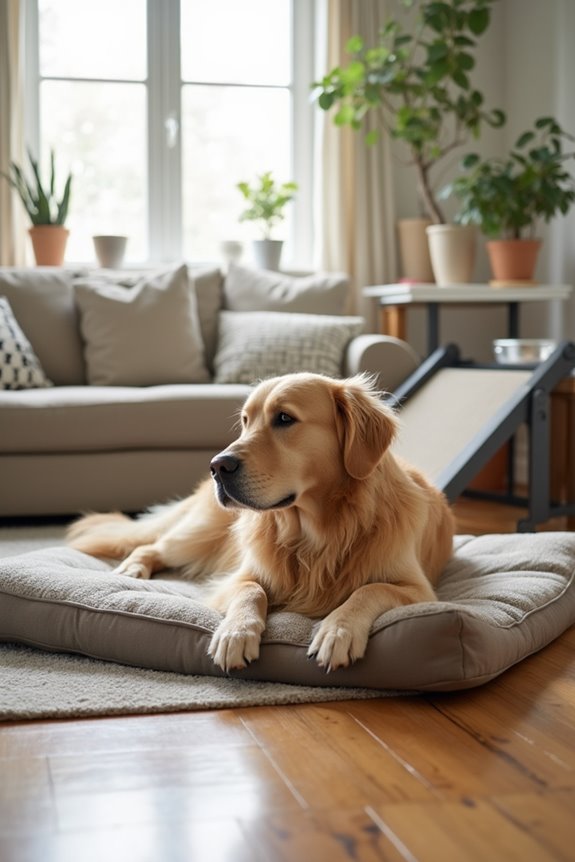
Guaranteeing mobility and physical comfort for senior dogs is essential, given their changing physical condition. I’ve found that implementing mobility aids can be transformative for my dog’s well-being. Ramps provide safe access to furniture and cars, reducing the strain on aging joints. Joint supplements like glucosamine and omega-3 fatty acids have also been beneficial; after consulting my veterinarian, we incorporated them into his routine. Additionally, joint health benefits such as reduced inflammation and improved mobility are notable advantages of these supplements.
To keep our home safe, I’ve installed non-slip rugs, cleared obstacles, and guaranteed adequate resting areas. Regular, low-impact exercise, such as short walks, keeps his muscles engaged while preserving joint health. Always consider your senior dog’s specific needs, adjusting home modifications and routines as necessary to enhance their mobility and comfort.
Cognitive and Sensory Support Strategies
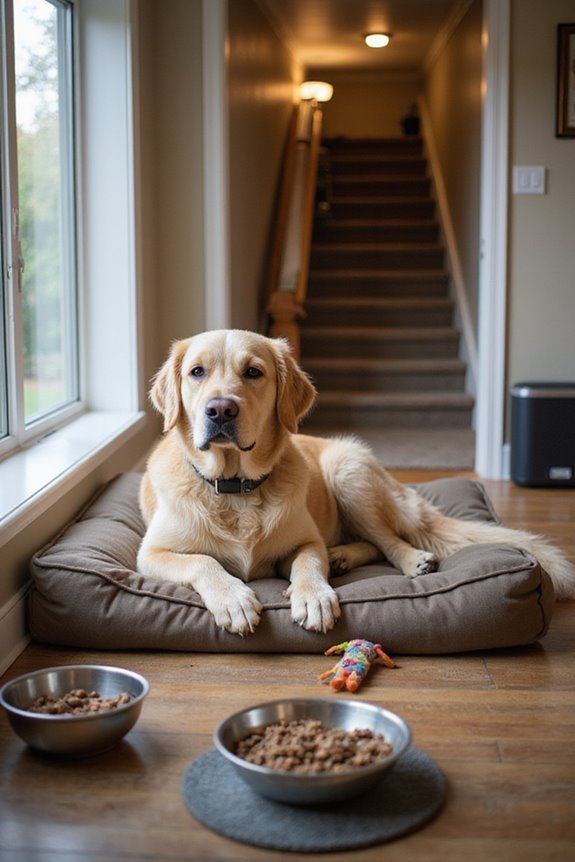
Maintaining physical comfort in senior dogs is only part of the overall strategy to enhance their quality of life. To support cognitive stimulation, I recommend incorporating interactive toys and puzzle feeders into their routine. Rotating these toys can prevent boredom and stimulate their minds. Gentle training sessions and scent games can also engage their natural instincts and memory.
For sensory adaptations, consider improving their environment by ensuring adequate lighting and reducing noise. Consistent commands can help ease confusion caused by sensory decline. Additionally, gentle massages or textured toys create tactile engagement, enhancing their sensory experience. Remember, a well-balanced diet, rich in antioxidants and omega-3 fatty acids, supports brain health and cognitive function. Prioritizing these strategies can greatly enhance your senior dog’s daily life. Furthermore, integrating joint supplements for mobility can also aid in maintaining their physical activity and overall well-being.
Managing Chronic Diseases and Medications
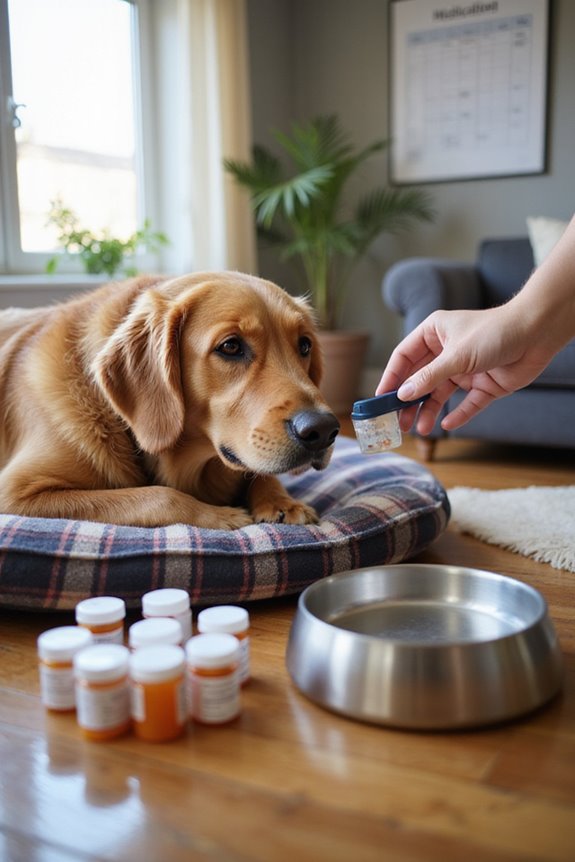
Managing chronic diseases in senior dogs requires a thorough approach to guarantee their well-being and quality of life. Regular veterinary check-ups, ideally twice a year, are essential for early detection of conditions such as arthritis or kidney disease. Incorporating effective medication management is imperative; maintain updated lists to prevent errors and administer medications consistently. Monitoring for side effects is important, allowing adjustments as needed.
Consider complementary therapies like physical rehabilitation or acupuncture to enhance pain relief. Additionally, using wearable technology can track mobility changes, providing insight into your dog’s evolving health status. With a systematic approach combining traditional and integrative therapies, you can notably improve your senior dog’s quality of life despite chronic illness, ensuring they experience comfort and dignity. Furthermore, incorporating senior dog supplements can provide essential support for joint health and overall well-being.
Creating a Safe Home Environment
Creating a safe home environment for senior dogs is vital for their comfort and well-being, as they often face challenges related to mobility and health. Here are some important pet-friendly modifications to enhance home safety:
- Mobility Aids: Consider using pet ramps or stairs to reduce joint stress and prevent falls, especially from couches or beds.
- Flooring Safety: Replace slippery surfaces with non-slip rugs and carpet runners to improve traction and stability.
- Clutter Management: Keep floors free of hazards like toys and cords to minimize tripping risks.
- Comfort Zones: Provide orthopedic beds in quiet areas to support joint health and promote restful sleep. Orthopedic dog beds can provide essential support for joint pain relief.
- Accessibility: Verify food and water bowls are conveniently placed at ground level to ease access.
These thoughtful adjustments can greatly improve your senior dog’s quality of life at home.
Exercise and Physical Activity Recommendations
For senior dogs, regular exercise and physical activity are essential to maintain their health, mobility, and overall quality of life. Here are key recommendations:
- Walking: Aim for two 30-minute walks daily on soft surfaces like grass to reduce joint strain. Adjust pace based on your dog’s comfort, and watch for signs of fatigue.
- Water Exercises: Swimming is an excellent low-impact activity that builds muscle tone without stressing joints. Always guarantee a safe area for swimming, and dry your dog promptly after.
- Gentle Play: Engage in low-impact play, avoiding jumps or twists that stress aging joints. Socialize with calm dogs to maintain emotional well-being.
These activities will help keep your senior dog healthy and happy while preventing further complications.
Grooming and Maintaining Health
Grooming is an essential aspect of care for senior dogs, as it not only maintains their appearance but also supports their overall health and well-being. Employing the right grooming techniques is vital. Opt for softer brushes that cater to their sensitive skin, ensuring you use gentle strokes to avoid irritation.
Consider these key points for effective grooming:
- Schedule multiple short sessions throughout the day to minimize stress.
- Inspect their skin and coat regularly for unusual changes.
- Use mild, senior-safe shampoos for bathing, keeping sessions brief to prevent discomfort.
- Check nails frequently to maintain mobility and prevent pain. Additionally, ensure they have a comfortable orthopedic dog bed to help alleviate joint pressure during rest.
Mental and Emotional Wellbeing for Senior Dogs
As dogs age, their mental and emotional wellbeing becomes increasingly essential to their overall quality of life. Prioritizing emotional support and social bonding can greatly enhance your senior dog’s happiness. Here are some effective strategies:
- Engagement: Use interactive toys or simple training to provide mental stimulation, helping to slow cognitive decline.
- Routine: Maintaining a consistent daily schedule can reduce anxiety and promote stability, ensuring comfort and familiarity.
- Social Interaction: Regular walks and safe interaction with other dogs or trusted humans prevent feelings of isolation.
- Physical Affection: Gentle petting and reassurance through your voice can foster feelings of safety, reducing stress.
Frequently Asked Questions
How Can I Tell if My Senior Dog Is in Pain?
Noticing pain indicators in my senior dog’s behavior can be tough. I look for changes like increased irritability, reluctance to interact, and difficulty moving. These behavioral changes often signal they’re in discomfort, needing my attention.
Should I Change My Dog’s Bedding as They Age?
As my dear senior pup ages, I’ve found it’s essential to refresh those bedding materials for their comfort considerations. A snug, supportive bed truly helps them feel cherished and content in their golden years.
Can Senior Dogs Benefit From Interactive Toys?
Absolutely, my senior dog loves interactive toys! They provide cognitive stimulation while promoting physical activity. Watching him engage and play brings me joy, and I can tell it keeps his spirit lively and his mind sharp.
How Often Should I Monitor My Dog’s Weight at Home?
Did you know that 60% of senior dogs struggle with weight issues? I’ve found monitoring my dog’s weight weekly is essential for effective weight management, employing simple techniques to track changes while providing a loving, supportive home environment.
What Signs Indicate My Dog May Need More Medical Attention?
If I notice my dog showing unusual behavior or decreased activity, I immediately consider visiting the vet. It’s essential to monitor their wellbeing closely because even subtle changes can indicate serious health concerns.


